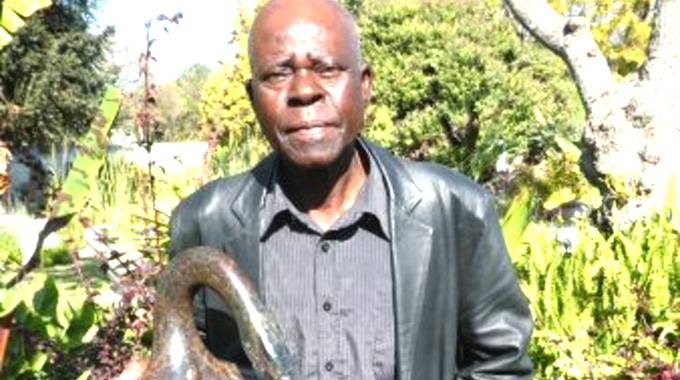Reflecting on six decades of sculpture

Kundai Marunya Arts Correspondent
He sits in a makeshift shade, his workshop for many years. His grey head seems to weigh heavy on his shoulders, probably from wisdom acquired in his over 80 years of life.
Yes, his strength may be failing him. After all, he has given a breath of life to many stones in more than half his days on earth.
But he carves on, employing assistance when need arises.
Some of his sculptures have reached far destinations he can only dream to set foot on. His protégés have gone on to conquer the world with the knowledge he imparted to them.
Some are inspired by his creations, many wish to be like him, or at least have half his creativity while others have gone on to copy his style. He takes no offence in it, to him it all comes with pioneering the trade.
This is the life of first generation sculptor Sylvester Mubayi. A father, a grandfather, a husband but most of all a sculptor, one of the first and best to come out of Zimbabwe.
Born in 1942 in Chihota near Marondera, Mubayi first worked as a tobacco grader after leaving school.
He moved to Harare in 1966 to seek employment at Chibuku Breweries before he went to Tengenenge, in Guruve at the heart of the country’s stone sculpture a year later.
“My first encounter with stone sculpture was at Tengenenge. When I expressed my interest to join the trade I was just given stones, tools and a spot in the shade of a tree to work from, far away from the others so that no one can disrupt you from your thought process.
“We worked hundred metres apart. No one was allowed to visit another so that everyone could master their own unique style without copying or being influenced by another’s,” he said.
He spent days carving, trying to produce something worthwhile. With many false starts, self-correction and the deep thoughts that came with the serenity of isolation, he mastered his art.
His work is inspired by a world of spirit and supernatural forces often fusing people and the animal world. Skeletons inspired his early work.
His greatness is evident with the high number of major collections dotted across Europe and North America. Just two years after his first encounter with stone sculpture he was good enough to extensively exhibit world over.
Back home he sold many artworks through the National Gallery of Zimbabwe (NGZ). Thus his decision to work from the institution moving from Tengenenge in the 70s.
Experts at the iconic art institution still appreciate his mastery that they over the years took up over 26 of his sculptures to be part of their permanent collection. Former NGZ director Frank McEwen described Mubayi as the greatest sculptor.
Even 60 years later experts at NGZ still think him great that they chose him to represent the country, exhibiting at the 53rd Venice Biennale in Italy last year.
“Exhibiting in Italy gave me a fresh perspective on art, seeing different creation from world over.
“How things are progressing with other countries art-wise also gave me hope that even though sometimes we spend months without selling anything, with money not coming in, we are still in a good trade because people are increasingly appreciating art, ” said Mubayi.
While working from NGZ McEwen advised him to move out of the fast life Harare offers and he went on to buy land in Inyanga which became Mubayi’s new home for the next four years.
“While I was working at the gallery a group of Americans were impressed by my work and offered to take me with them to the United States where I was to work at the same time attending school on scholarship.
“This was the main reason why McEwen quickly moved me to Inyanga. He said if I was to remain at NGZ I would receive mouth-watering offers and one point I would be tempted to take them. He wanted me to keep working on my stones from home,” he said.
His life is full of interesting stories, meaningful connections and greatness in creation. Now he curves those stories while preserving history for generations to come.
Mubayi’s subject of interest these days is slave trade.
“The snails I’m curving these days are a metaphor of slave ships. I just want people to remember where we were so that going forward we will make wise decisions,” said Mubayi.
Through his craft, he has managed to build a house in Chitungwiza, educate his children and now his grandchildren. His love for art will not allow him to stop carving stones, not until his body gives in, but even then his assistant will take good instructions on what he needs done.To reinvigorate his strength, Mubayi networks with young sculptors, keeps on seeking new ways to perfect as well as sell his art and he has been working at Avac Arts.
“It pleases me that there are young people who are passionate about stone sculpture.
In the time I have worked with Avac Arts I find them professional and fair in their dealing, and I’m glad such young people are still there to carry on our legacy in stone sculpture,” he said.When he finally departs from earth, like most of his peers he started the trade with, Mubayi’s work will live on in through his children who also took on their father’s trade.
As with age comes wisdom, his wise words for coming generations of stone sculptors is to be original and carve from their hearts, dedicating their time to produce good work.









Comments